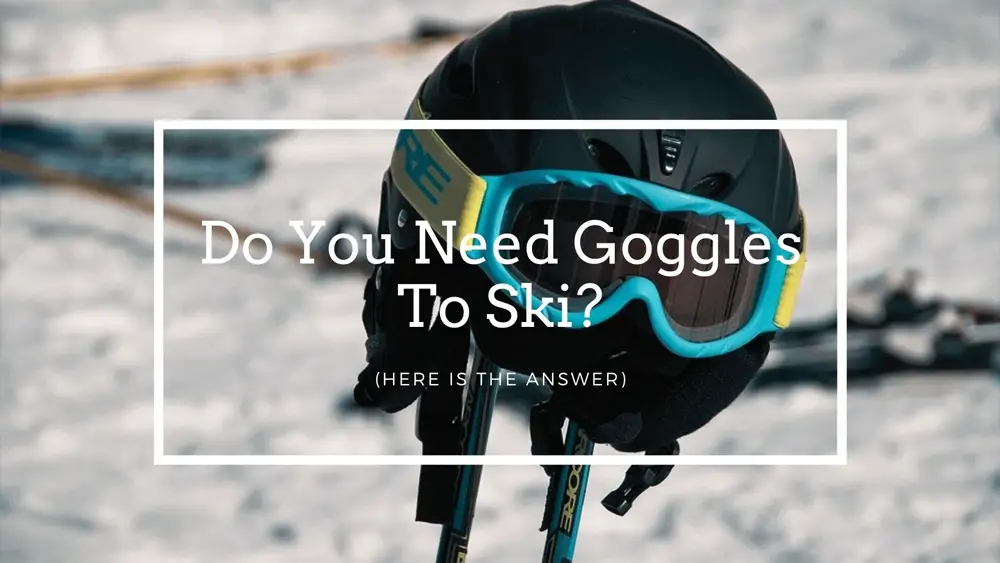If you love speed, any winter vacation would be incomplete without a round of cross country skiing!
Now, whether you ski competitively or just for fun, wearing proper apparel and safety gear is a must. While most know the importance of ski boots and helmets, the same cannot be said about goggles.
However, skiing can cause minute dust and snow particles to irritate your eyes, and the snow reflects the harsh sunlight, further blocking your vision.
Hence, we have curated this short guide to answer your question- Do you need goggles to ski? The different sections of the guide will help clarify various doubts regarding the benefits of wearing goggles, alternatives, and more.
Do You Need Goggles To Ski?
Skiing involves high-speed movement, and just like the rest of your body, your eyes will be prone to injuries or irritation from dust, wind, and sunlight. Thus, wearing goggles or sunglasses, preferably with a UV shield, is essential to keep your eyes safe. Doing so will also let you see clearly while skiing, so you can beat any friends in a race!
Moreover, when you opt for snow goggles, make sure you choose the lens color and type carefully. Most pro skiers opt for darker or mirrored lenses, as those block a lot of light.
On the other hand, you can experiment with different lens shades on cloudy days or when you don’t plan to go too high. Additionally, clear lenses are an ideal pick for those who like skiing in the dark.
Speaking of lens types, you can choose between two- cylindrical and spherical. While cylindrical lenses are curved horizontally, spherical lenses are curved both ways, allowing a wider view. Technically, the latter is a better choice, but it often comes with a high price tag.
Can You Ski Without Goggles?
Think about it this way- although you can ride a bike without a helmet, you wouldn’t compromise on safety. Similarly, we do not encourage you to ski without goggles.
Ski goggles do more than just make your entire ski outfit look good! They protect one of the most sensitive parts of your face, and protection should be your topmost priority while indulging in adventure sports.
Besides preventing dust and snow from entering your eyes, goggles help you see in poor visibility. The sun is often unforgiving as you go uphill and gets blinding when reflected from the snow. But with goggles featuring hi-tech lenses, you can protect your eyes from the harsh UV rays and the potential risk of snow blindness.
Moreover, thanks to the snug fit, ski goggles can protect you from fallen branches and leaves, larger pieces of ice, or rocks that may cause dangerous mishaps.
Why Do You Need Goggles For Skiing?
As mentioned earlier, ski goggles are protective gear for your eyes, the most sensitive and vital part of your body. Vision is a gift, and it is best to cherish and protect it as much as we can.
When you’re rushing down a slope at high speed, you never know what’s going to come your way. The harsh sunlight and strong winds further make your vision blurry. That’s when wearing snow goggles can limit any chances of minor accidents turning into major unfortunate events.
In fact, it even prevents long-term eye problems that may develop in the future.
Can I Wear Sunglasses While Skiing Or Snowboarding?
Although goggles are the best safety gear for your eyes, you can opt for sunglasses on clear days or when you won’t indulge in intense skiing. Since sunglasses are lighter and obviously more stylish, you can pick them over goggles when you have other commitments before or after hitting the slopes.
However, keep in mind that sunglasses neither offer a snug fit nor full coverage. Additionally, sunglasses will hardly be of any help if you end up falling or crashing while skiing.
Can I Wear My Glasses When I Ski?
Yes. If you invest in a pair of over-the-glass (OTG) goggles, you can wear prescription glasses underneath. This way, you will be able to see clearly as you glide through breathtaking landscapes while protecting the eyes from possible damage.
Alternatively, you can check out designer sunglasses for days when the sun is not too harsh. Some of these products can easily fit under OTG goggles and look great once you take them off.
FAQs:
Do You Need Special Ski Goggles To Wear With A Helmet?
No, all types of ski goggles are designed such that they are compatible with ski helmets. Moreover, these goggles are equipped with an adjustable strap, while the ski helmets feature a clip, both of which are used to secure the two accessories.
However, we still recommend trying on your goggles with the helmet on while shopping for such gear.
Do You Need Goggles For Night Skiing?
Yes, as mentioned earlier, you can opt for clear goggles for night skiing. Usually, such goggles are cheaper than those with darker lenses as they are easier to produce.
Also, goggles for night skiing are not meant to block out harsh light. You only get protection from physical elements like snow, dust, and wind.
What Size Ski Goggles Do I Need?
The ideal size of ski goggles depends on your head size and face shape. The different sizes of goggles are usually termed as small frame, medium frame, and large frame. Some goggles are even differentiated as adult, women’s, and kid’s ski goggles.
Additionally, you can find alternative-fit ski goggles to fit the Asian face type. Other than the frame size, you can always customize the overall fit with the help of the adjustable elastic strap.
Final Thoughts
With that, we come to the end of this short but informative guide on ski goggles. While the eyewear may look bulky and feel uncomfortable initially, you will soon get the hang of it. Believe us, your eyes will thank you for the effort!
When buying a suitable pair of snow goggles, a pro tip would be to check if the fit is snug and secure. The curvature should hug your nose bridge and cheeks perfectly to provide the right amount of coverage. But ensure that it’s not too tight and uncomfortable. Also, investing in goggles with interchangeable magnetic lenses will give you more freedom of customization later.


